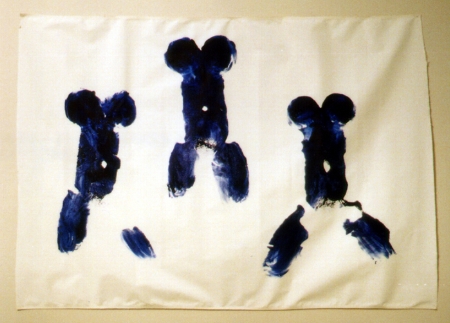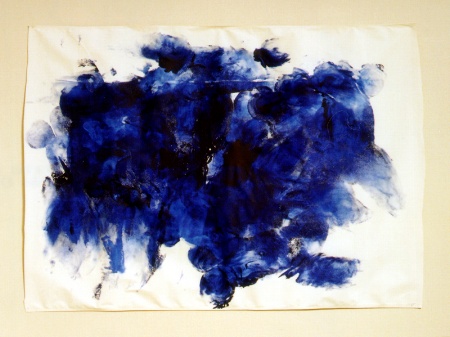| Back to show catalogue | ||
|
The Anthropometric Mystery - Jean-Paul Cloutier painting monochromes slightly monotonous. At this period in his career he was in need of a change.
In 1959, Klein witnessed Tinguely's "Meta-matic 17", which was a machine
created by the artist to produce random drawings automatically. He
was interested in the machine both as a work of art and as a creator
While
it was Tinguely's machine that inspired Klein to consider and "explore
speed- speed as vitality, not velocity"(Stich171), the nude models provided
the brush he would use for this exploration and Judo teachings would provide
a basis for understanding the concept of Anthropometry. The method for
the anthropometric works was to cover a model in his Blue and have her
spread the paint over the surface to be painted under Klein's strict direction.
The resulting print caused Klein to recall the imprint that a body makes
after falling on a dojo
On June 5, 1958, Klein created his first body painting in the apartment of Robert Godet. The reaction to this first painting was that of a sensual and sexual experience. Klein felt that the artwork created by the woman writhing around naked in blue paint deserved more recognition than that of a simple sexual or sensual experience. So, it was not until February of 1960 that Klein publicly presented another Anthropometry, only this time he ensured that the setting would elicit an artistic air. The Anthropometry performance created as a total experience. It took on the theatrical flair that Klein demonstrated with the Void. This was designed not as a simple exhibition of anthropometric works already completed, but as a performance intended to allow the audience the privilege of witnessing the creation of art works. The performance was held at the Galerie Internationale d'Art Contemporain. One hundred guests assembled to watch Yves Klein in action. Klein also employed nine musicians to play the monotone symphony, which was essentially a one note piece of music played repeatedly with long breaks. When the models took the stage, their were mixed reactions from the audience that was not sure what to expect; a reaction that Klein must have enjoyed. Three nude models being smeared with paint to create art works created some scandal and controversy. Klein was attempting here to do what Tinguely succeeded in doing with his machine. He was obsessed with the removal of the hand of the artist. This was evident in his monochromes and his use of rollers and sponges to apply paint to hide his mark. By using the body of a model, Klein separated himself one step further from the paint. He was to the models like Tinguely was to the machine. Such a statement can also cause some controversy because it was not Klein who created the models, but for his purposes, he did select them and direct their movements much like an artist moves and directs a brush. The paintings remain Klein originals because of his direction, the models represent nothing more than mere paintbrushes, objects of his control. He does contradict himself however, by using his own body to create a painting. In this, he had manifestly shown the mark of the artist, with the artist himself being the brush. With these paintings also emerged another of Klein's concepts: "art is health"(Stich175). Here, he was commenting on the vitality of the body, not sexual vitality but as living flesh covering unintellectual involuntary organs. He felt that the trunk of our body contained our real existence. All of our vital organs exist in this space and this space maintains our healthy spirit. So with this in mind, looking at the anthropometric works, we understand that Klein was attempting to illustrate the core of our existence.
In addition
to the blue body paintings, Klein experimented with other techniques and
ideas. Three of these, one using blood, one using a textured surface,
and one using a giant crane like machine, were conceptualized but not totally
realized. The blood painting was created but then destroyed for its
unsettling effect on Klein. A fourth technique, Negative Imprinting,
was used successfully. These paintings employed the nude women in
various poses, and involved spraying paint over them leaving the space
where their body was untouched. They seemed to illustrate the aura
of the body. These negative imprints made Klein interested in the
concept of Cannibalism. The extreme sexual gratification, orgasmic
ecstasy, orgiasitic chaos, and violence that the
In order to truly understand the artistic emotions surrounding the creation
of a body painting, to experience what Klein himself experienced, it is
necessary to reproduce the act of the painting. Though the piece
I created was not before an audience of 100 people, I did not have any
musicians available to play a monotone symphony for me, and I used one
model instead of three, I feel that under the circumstances I recreated
the same atmosphere that Klein would have worked in with his models.
I chose to do the Anthropomorphy for my own
The second body painting I created in collaboration with my model was in
the style of Klein's "Great Blue Anthropomorphy". For this piece,
I tried to gain more control on the outcome by lightly sketching an outline
on the paper, like Klein, for my model to follow. I wanted her to
move the paint with her body so that the surface would be much more abstract
than the previous artwork. During the process, I felt as though I
had less control than the previous painting. Also, the movements
and gestures were more physical and sensually charged than
Upon completion of the two paintings, I feel I understand much ofwhat Klein
was trying to do with his paintings. The finished works do transcend
time; they are nither present, nor past, nor future, but they mark an instant
that can never be described or repeated. It exists, as Klein demonstrated,
outside of the phenomenology of time. They exist now as a sign/signifier
to a human form. Now, the extent to which this sign can represent
the essence of human existance must be left to imagination and faith in
Klein's theories. I have seen why this style of painting may have
been regarded as scandalous, focusing on the naked female torso.
It was difficult to act impartially as artist and director and not at all
as a voyeur. Upon completion of these paintings, I have developed
a deeper understanding of Klein's theories and rational behind the anthropometry
painting with some faith and conceptualization.
Works Cited Sidra Stich. Yves Klein. 1994 |
||
 Klein would soon find the next logical step in his art practice.
At this time, he was in the habit of hiring models to walk around his studio.
He enjoyed the aura they projected in his studio. They were not hired
to be painted, but to fill the studio with the creative influence such
as the of influence that landscapes have on landscape painters He
was not interested in the body itself, he had a deeper interest in the
body than its curves and form. It was the combination of Tinguely's
machine and the constant influence of the naked bodies that led him to
his next artistic revelation that would become known as, Anthropometry.
Klein would soon find the next logical step in his art practice.
At this time, he was in the habit of hiring models to walk around his studio.
He enjoyed the aura they projected in his studio. They were not hired
to be painted, but to fill the studio with the creative influence such
as the of influence that landscapes have on landscape painters He
was not interested in the body itself, he had a deeper interest in the
body than its curves and form. It was the combination of Tinguely's
machine and the constant influence of the naked bodies that led him to
his next artistic revelation that would become known as, Anthropometry.
 The sexual aura that these paintings display is not easily ignored.
The focus is definitely on the female form. In his 1960 performance,
male models could have been used as well as female models. Male models
could have been hired to walk around his studio if their only purpose was
not for looking at and studying, but rather for the aura they created.
Stich points out that the manner in which the paintings were created were
highly voyeristically charged. The model was naked to the audience,
set up on a stage to watch while Klein, well dressed, called out orders.
The models were subservient to the orders of Klein. Also, the portion
of the body that was painted, which according to Klein contains the essence
of our existence, also coincidentally contains the breasts and reproductive
organs of the female, both highly fetishistic. The thighs are displayed
spread wide open, which can be read as a sexual gesture. Therefore,
to nod and accept these body paintings as merely spiritual and "resurrections
from the body", can be fairly difficult to accomplish. It becomes
very easy
The sexual aura that these paintings display is not easily ignored.
The focus is definitely on the female form. In his 1960 performance,
male models could have been used as well as female models. Male models
could have been hired to walk around his studio if their only purpose was
not for looking at and studying, but rather for the aura they created.
Stich points out that the manner in which the paintings were created were
highly voyeristically charged. The model was naked to the audience,
set up on a stage to watch while Klein, well dressed, called out orders.
The models were subservient to the orders of Klein. Also, the portion
of the body that was painted, which according to Klein contains the essence
of our existence, also coincidentally contains the breasts and reproductive
organs of the female, both highly fetishistic. The thighs are displayed
spread wide open, which can be read as a sexual gesture. Therefore,
to nod and accept these body paintings as merely spiritual and "resurrections
from the body", can be fairly difficult to accomplish. It becomes
very easy